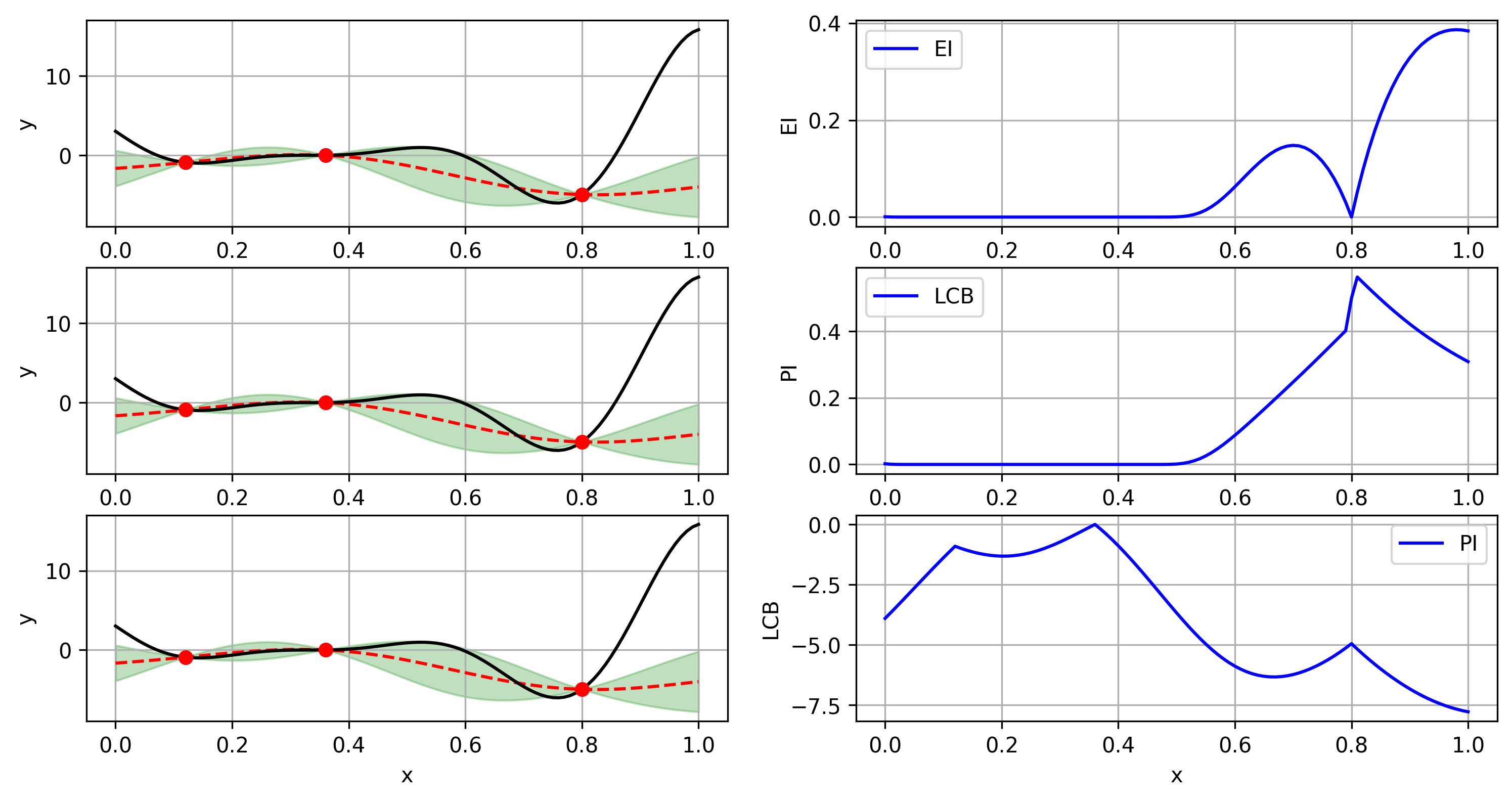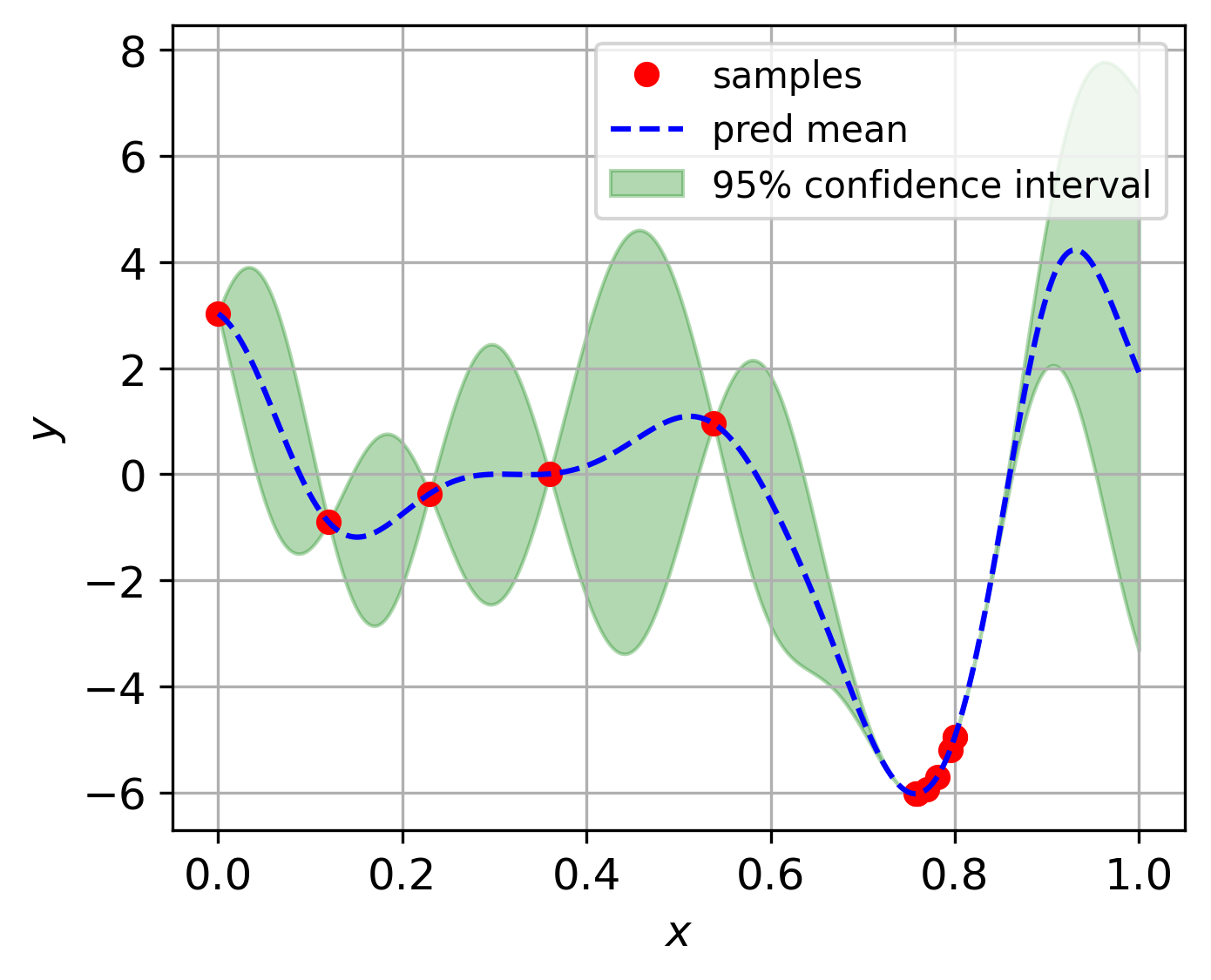Optimization is needed also everywhere in the field of machine learning, and also in the field of product, structure, and material design. In this packages, we have implemented a few optimization algorithms, which can be categorized into two groups:
1. Evolutionary algorithms
2. Single fidelity Bayesian optimization
3. Multi fidelity Bayesian optimization
Evolutionary algorithms¶
Evolutionary is a class of algorithms inspired by the biological evolution, and they don’t require the gradient information of the objective function. In this package, we have implemented the following evolutionary algorithms:
particle swarm optimization (PSO)
differential evolution (DE)
Particle swarm optimization¶
Particle swarm optimization (PSO) is a population-based stochastic optimization algorithm. The basic idea of PSO is to simulate the social behavior of birds flocking or fish schooling. In PSO, each particle has a position and velocity, and the position of each particle is updated according to certain rules. More details can be referred to [1]
Implementation
from mfpml.problems.sf_functions import Forrester
from mfpml.optimization.evolutionary_algorithms import PSO
# define problem
problem = Forrester()
# initialize the PSO class
pso = PSO(num_gen=100, num_pop=20)
# run the optimizer
best_results = pso_opt.run_optimizer(
func=function.f,
num_dim=function.num_dim,
design_space=function.input_domain,
print_info=False,
)
Differential evolution¶
Differential evolution (DE) is a population-based stochastic optimization algorithm. The basic idea of DE is to generate a new population by adding the weighted difference between two randomly selected population members to a third population member. More details can be referred to [2]
Implementation
from mfpml.problems.sf_functions import Forrester
from mfpml.evolutionary_algorithms import DE
# define problem
problem = Forrester()
# initialize the DE class
de = DE(num_gen=100, num_pop=20)
# run the optimizer
best_results = de.run_optimizer(
func=problem.f,
num_dim=problem.num_dim,
design_space=problem.input_domain,
print_info=False,
)
Single-fidelity Bayesian optimization¶
Bayesian optimization is a powerful tool to handling expensive optimization problems. The basic idea of Bayesian optimization is to use Gaussian Process model to approximate the objective function, and then use the predictive mean and variance to determine the next sampling location.
The criterion of Bayesian optimization is called acquisition function, which is a function of predictive mean and variance. The acquisition function is used to determine the next sampling location. There are several acquisition functions, such as Expected Improvement (EI), Probability of Improvement (PI), Lower Confidence Bound (UCB), and so on.
2.1 acquisition functions¶
Expected Improvement (EI)
where \(\mathbf{x}^+\) is the best observation so far. The above expression can be simplified as:
where \(\Phi\) and \(\phi\) are the cumulative distribution function and probability density function of standard normal distribution, respectively.
Probability of Improvement (PI)
Lower Confidence Bound (LCB)
where \(\kappa\) is a hyper-parameter, which is usually set to be 2.
2.2 Schematics of Acquisition function on Forrester function¶

Schematics of acquisition function on Forrester function¶
2.3 Bayesian optimization implementation
from mfpml.problems.sf_functions import Forrester
from mfpml.optimization.sf_uncons_bo import BayesUnConsOpt
from mfpml.optimization.sf_uncons_acqusitions import EI
# define problem
problem = Forrester()
# initialize the BayesOpt class
bayes_opt = BayesUnConsOpt(problem=func,
acquisition=EI(),
num_init=3,
verbose=True,
seed=4)
bayes_opt.run_optimizer(max_iter=10, stopping_error=0.01)

Bayesian optimization on Forrester function¶
Implemented single fidelity acquisition functions¶
Methods |
API of sampling methods |
|---|---|
Expected Improvement |
|
Probability Improvement |
|
Low Confidence Bound |
Multi-fidelity Bayesian optimization¶
Multi-fidelity Bayesian optimization is getting more popular nowadays, because it can integrate multi-fidelity data to improve the optimization performance. However, the research of Multi-fidelity Bayesian optimization is still in its infancy.
We have published several papers on the topic of multi-fidelity Bayesian optimization, and basically the methods introduced about multi-fidelity Bayesian optimization are implemented based on our published papers and the methods that been compared in our research.
In this repo, we make the implementation of multi-fidelity Bayesian optimization as general as possible,
meaning one only needs to define a multi-fidelity kriging model mf_gaussian_process and getting
a multi-fidelity acquisition function mf_acqusitions to run the multi-fidelity
Bayesian optimization.
Implementation¶
Here gives an example on how to use the multi-fidelity Bayesian optimization.
from mfpml.problems.mf_functions import Forrester_1a
from mfpml.optimization.mf_uncons_bo import mfUnConsBayesOpt
from mfpml.optimization.mf_acqusitions import AugmentedEI,
# define problem
problem = Forrester_1a()
# define the optimizer
optimizer = mfUnConsBayesOpt(problem=problem,
acquisition=VFEI(),
num_init=[5, 20],
)
# execute the optimizer
optimizer.run_optimizer(max_iter=20, stopping_error=0.01, cost_ratio=5.0)
Implemented multi-fidelity acquisition functions¶
Methods |
API of sampling methods |
|---|---|
Augmented EI |
|
VFEI |
|
VFLCB |
|
ExtendedPI |